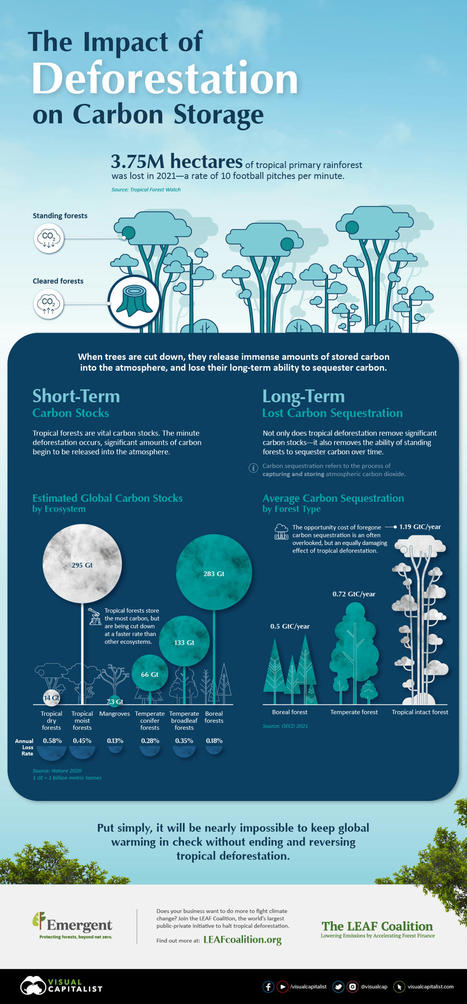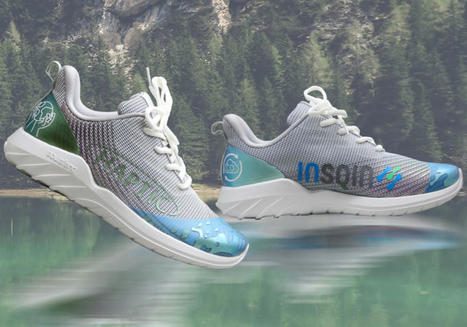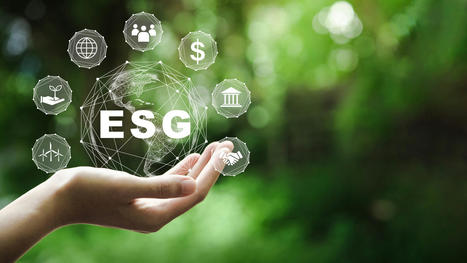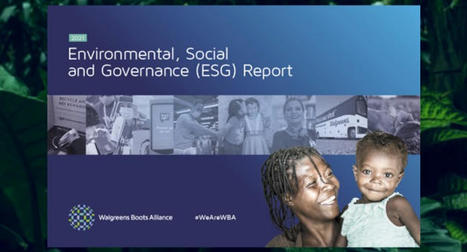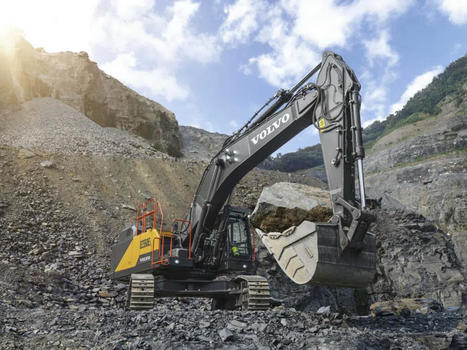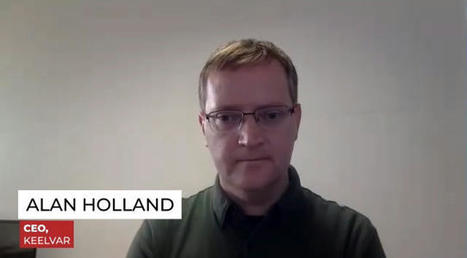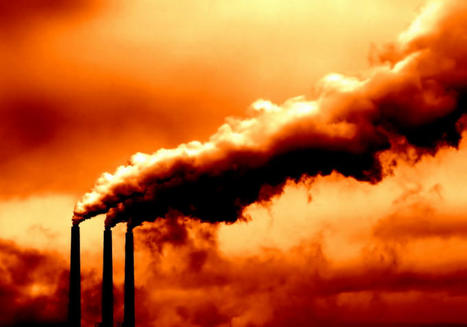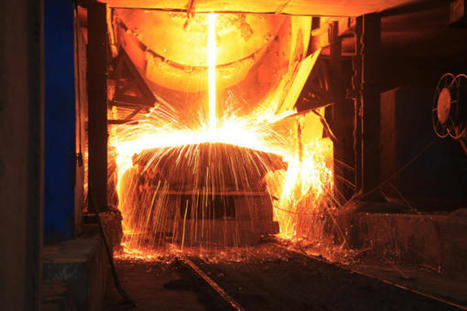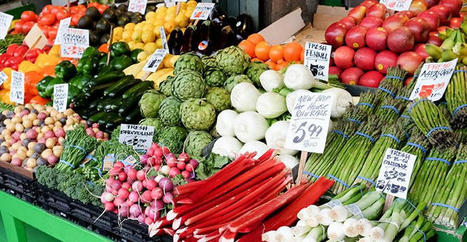 Your new post is loading...
 Your new post is loading...
According to Our World in Data, the global population emits about 34 billion tonnes of carbon dioxide (CO₂) each year.
Where does all this CO₂ come from? This graphic by Adam Symington maps out carbon emissions around the world, using 2018 data from the European Commission that tracks tonnes of CO₂ per 0.1 degree grid (roughly 11 square kilometers).
This type of visualization allows us to clearly see not just population centers, but flight paths, shipping lanes, and high production areas. Let’s take a closer look at some of these concentrated (and brightly lit) regions on the map.
Via EcoVadis
Online retailer Shein plans to cut emissions across its supply chain by 25% by 2030, the company announced in September.
The targets are among the first public steps to cut carbon emissions for the company, which has become a formidable player in the U.S. fast fashion market. The growth has come with a heavy carbon footprint. Last year, Shein’s operations produced 6.3 million tons of carbon dioxide emissions.
“Today we’re taking a significant step forward, announcing a new set of 2030 goals that will help us accomplish emissions reduction targets for our entire supply chain over the next seven years,” said Adam Whinston, global head of ESG at Shein.
As part of its efforts, Shein set a series of sustainability goals using 2021 data as a benchmark, compiled as a greenhouse gas emissions inventory with the help of certification company Interek. The retailer outlined reduction targets for each emissions level, which includes working with hundreds of suppliers to implement greener practices.
BY THE NUMBERS: SHEIN’S EMISSIONS GOALS
42% - Percent by which Shein aims to reduce its scope 1, owned-operations emissions by 2030
500 - The number of partner facilities Shein and the Apparel Impact Institute will work with to implement energy-savings programs, as part of its scope 3 emissions targets
25% - The percent by which Shein aims to reduce its scope 3 emissions by 2030
Via EcoVadis
The Impact of Deforestation on Carbon Storage
A one degree change in temperature could have catastrophic consequences.
One of the most notable influences on rising global average temperatures comes from deforestation. In fact, combined emissions from deforestation are higher than the annual emissions of any other country (apart from the U.S. and China) and contribute to roughly 12% of total annual greenhouse gas emissions.
This graphic from The LEAF Coalition takes a closer look at the impact deforestation has on global greenhouse gas emissions through carbon storage.
Via EcoVadis
The logistics giant Maersk will order eight new ocean-going ships that will use only carbon-neutral fuels to hit its net-zero goal by 2050. While it will be a more expensive endeavor than traditional vessels that run on fossil fuels, it is in line with what its customers want. They include: Amazon, Disney, H&M Group, HP Inc., Levi Strauss & Co., Microsoft, Novo Nordisk, The Procter and Gamble Company, PUMA, Schneider Electric, Signify, Syngenta, and Unilever. More than half of Maersk’s 200 largest customers have set – or are setting – ambitious science-based or zero-carbon targets for their supply chains.
Via EcoVadis
With regulators, investors and customers demanding cleaner business processes, companies understand the need to improve, but can find it daunting to start measuring all the ways they emit carbon. Organizations must understand Scope 1, 2 & 3 emissions, address ESG issues (environmental, social, governance) and get to grips with terms like “carbon-neutral” or “net-zero” and how they apply to their business operations and strategic objectives.
Via EcoVadis
Today, Amazon and Global Optimism announced that more than 300 companies have now signed The Climate Pledge, a nearly 600% growth in signatories over the past year. Among the nearly 100 new signatories joining today are the world’s largest container shipping company, Maersk; the leading enterprise software developer SAP; the North American timberland company Weyerhaeuser; the largest residential solar company in the U.S., Sunrun; and the leading brand in connected car and audio services, HARMAN. Pledge signatories in total generate over $3.5 trillion in global annual revenues and have more than 8 million employees across 51 industries in 29 countries.
Signatories to The Climate Pledge must agree to:
Measure and report greenhouse gas emissions on a regular basis.
Implement decarbonization strategies in line with the Paris Agreement through real business changes and innovations, including efficiency improvements, renewable energy, materials reductions, and other carbon emission elimination strategies.
Neutralize any remaining emissions with additional, quantifiable, real, permanent, and socially beneficial offsets to achieve net-zero annual carbon emissions by 2040.
Via EcoVadis
German polymer materials manufacturer Covestro and Chinese companies Huafeng and Cyclone say they have jointly developed a 'more sustainable' way of producing high-quality running and sports shoes.
It makes use of Covestro's Insqin waterborne polyurethane (PU), textile technology company Huafeng's Haptic 3D textile printing system and recycled PET fibers from Cyclone to signficantly reduce carbon emissions.
Cyclone's recycled polyester yarns are used for the shoe uppers and coated using Huafeng's 3D Haptic textile printing process and Covestro's partially bio-based Impranil eco DLS polyurethane (PU) dispersion as a binder.
Via EcoVadis
As momentum builds around embarking on a net-zero pathway, advanced technologies can serve to leverage operational benefits across every aspect of the energy value chain, explains Damien McDade, Vice President Pacific at AVEVA.
As global resolve begins to coalesce around the energy transition, 2022 will mark a turning point for industrial enterprises. At the recent COP26 summit, governments and private-sector companies around the world pledged to work towards keeping planetary warming to 1.5°C, and to support net-zero carbon emissions by 2050.
Now comes the difficult challenge of taking action to make good on those promises, while complying with stricter Environmental, Social, and Governance (ESG) regulations.
Businesses in mature industries such as oil and gas, mining and metals, and power generation and chemicals will need to address new business imperatives if they are to build an alternative, sustainable energy landscape while maintaining current operations continuity.
Via EcoVadis
Amsterdam Airport Schiphol is investing in two TaxiBots, becoming the first in Europe to use the special towing vehicles that enable aircraft to taxi sustainably.
The sustainable taxiing process sees aircraft taken to and from the runway by a special towing vehicle, with the aircraft engines remaining largely switched off. The TaxiBots, supplied by Smart Airport Systems, will enter service at Schiphol in mid-2022.
A previous trial at the airport demonstrated that sustainable taxiing reduces fuel consumption during taxiing by around 50%, thereby lowering carbon, nitrogen and ultrafine particle emissions. Indeed, given the distance involved, fuel savings can reach up to 65% when aircraft taxi to the Polderbaan – Schiphol’s sixth, and most distant, runway.
Via EcoVadis
Walgreens Boots Alliance (WBA) has published its 2021 Environmental, Social and Governance (ESG) Report, which includes the company’s plans for advancing its sustainability agenda.
The company continues to strive to meet its customers’ expectations for responsibly sourced products that contribute to a healthy planet and community wellbeing. For example, WBA committed to reducing its carbon emissions by 30 percent by 2030 compared with 2019.
Packaging is also a large part of WBA’s sustainability agenda.
Via EcoVadis
Strong financial outcomes and sustainability focused leadership is required for long term impact, according to a new report from IDC.
In the document, IDC FutureScape: Worldwide Sustainability 2022 Predictions - APEJ Implications, IDC has identified the top 10 predictions for environmental, social, and (corporate) governance (ESG) in 2022 and beyond.
The report provides organisations with context and underlying drivers for IT investments supporting ESG initiatives for the predictions.
According to IDC, the last two years have seen significant debate and mixed results in the area of climate change. The world has experienced a brief reprieve in emissions due to lockdowns in early 2020. However, emissions increased beyond pre-pandemic levels in 2021.
The UN Climate Change Conference (COP26) has amplified the climate change plan. Even so, critics question whether the agreements articulated are enough.
In the Asia/Pacific region, the drivers that result in concrete sustainability outcomes are still primarily financial, the analysts state.
Via EcoVadis
Honeywell, an American conglomerate specializing in various industries, including manufacturing. It has recently committed to reaching carbon neutrality by 2035 and plans on achieving this goal through investments in energy-saving projects, a transition to renewable power sources and other similar initiatives.
The U.S.-based company’s sustainability goals have been at the forefront of its operations since 2004, and since 2010, it has taken on over 5,700 sustainable projects and saved $100 million per year.
Another notable company is Henkel, is a leader in the household and personal care manufacturing market. It has a comprehensive sustainability strategy that’s been the focus of its operations for 140 years. The company believes eco-friendliness and business success go hand in hand.
Henkel releases its sustainability report annually, showing goals it’s reached or is striving to. The organization ranked among the “2021 Global 100 Most Sustainable Corporations in the World,” a notable achievement that only a few organizations receive.
Then there is Ørsted, a multinational power company located in Denmark, which has made noteworthy progress in achieving its sustainability goals. The world’s most sustainable company for three years running, Ørsted says it is committed to fighting climate change, transitioning to renewable energy and decarbonizing the global supply chain. Ørsted has earned 62.2% of its revenue from renewable energy, reduced carbon emissions by 47% and spent millions of dollars in green investments.
Via EcoVadis
Current global emissions targets will only be achieved through the acceleration of innovative technologies, enabling industries to pivot their organizations towards sustainable operations. Digital technology may be the most powerful, scalable tool the world has to tackle climate change and 5G is at the forefront of this effort.
Operators of wireless networks have already taken numerous steps to limit emissions, such as reducing energy consumption, switching to more efficient network equipment, and sourcing renewable energy. However, offsetting the growth in data volumes over mobile networks will require more than improvements to current networks.
The impact of 5G is threefold in its potential to combat the effects of climate change: 5G, with its substantially greater energy efficiency, will reduce greenhouse gases, abate the emissions of other industries, and enable more precise monitoring of our environment to help meet broader climate change commitments.
Via EcoVadis
|
The BMW Group is systematically pursuing its climate goals for the supplier network and significantly reducing the carbon footprint of its steel sourcing. Following initial contracts with European suppliers, the BMW Group has now concluded further agreements for the supply of CO2-reduced steel in the US and China.
“Steel is one of the main sources of CO2 emissions in our supply chain. That is why we are comprehensively reorganising our steel portfolio – so we can supply our global production network with over on third of CO2-reduced steel from 2026. This will reduce the carbon footprint of our supply chain by 900,000 tonnes per year, while at the same time driving the transformation of the steel industry,” said Joachim Post, member of the Board of Management of BMW AG responsible for Purchasing and Supplier Network.
Via EcoVadis
“Investing in a circular economy approach must become an integral part of how companies run their supply chain,” said Stephen Jamieson, Global Head of Circular Economy Solutions at SAP. “As regulations become more widespread and investors increasingly favour circular business models, companies explore new ways to retain the value of their products.”
Circular economy as a competitive factor
The focus on a circular economy has clear financial benefits. Research by the Ellen MacArthur Foundation suggests 45 percent of CO2 emissions can be tackled by transforming the way goods are made and used. In times of growing CO2 prices, the circularity of products becomes a strong competitive factor and putting value on waste generates significant new revenue. Accenture estimates $25 trillion could be up for grabs by 2050.
In addition, circular manufacturing enables companies to:
- Retain and recapture the value inherent in the original equipment manufacturer’s existing products
- Reduce demand for new materials 50 to 98 percent
- Reduce energy consumption over new manufacturing 55 to 90 percent
A prominent example is Apple, whose products contain nearly 20 percent recycled materials such as gold, tungsten, rare earth elements and cobalt. These materials are also used in iPhone batteries and the plating of the main logic board or camera wires. Philips refurbishes medical imaging equipment like CT scanners, upgrades it and sells it again. Hospitals can trade-in their old equipment for a discount on new systems.
Via EcoVadis
Road transport is the most prioritized area to reduce CO2 emissions, according to leading e-commerce and manufacturing companies in Europe. A new report carried out by Ipsos and Volvo Trucks shows that companies are willing to pay more for transport suppliers with lower CO2 emissions.
The research company Ipsos has, on behalf of Volvo Trucks, interviewed 100 large e-commerce and manufacturing companies in eight European countries about their demand for fossil fuel free transports in future procurements.
The vast majority of these companies have set targets to reduce their climate footprint. 78% of those interviewed say that they are willing to pay more for a transport supplier with little or no CO2 emissions and 85% are prepared to change transport suppliers if they don´t meet their requirements.
Via EcoVadis
Heavy equipment users have a new tool from Volvo Construction Equipment to help with carbon reduction goals tailored to their operations.
The CO2 Reduction Program is designed to be integrated into an organization’s operational plans and offers insights, analysis, improvement possibilities and sustainability targets while working toward carbon neutrality. The approach will be designed specifically to each user’s goals and operations.
The program will start by analyzing where an organization stands on its carbon emissions to establish a baseline for making improvements. It will use data from connected machines to determine the carbon footprint for all machines, regardless of brand, that are in use. Volvo CE says this will help users visualize the impact of carbon reduction changes over time.
Via EcoVadis
Alan Holland, chief executive officer of Keelvar, describes the challenge of measuring the carbon emissions of suppliers in multi-tier global supply chains.
As defined by the Greenhouse Gas Protocol, Scope 3 emissions are those emanating from a company’s suppliers — in other words, those that lie outside the control of the original equipment manufacturer. Scope 3 emissions “are inherently more difficult to measure and control, because they’re not coming out of your factories,” says Holland. Sources include producers of components and raw materials, as well as transportation providers.
Growing awareness of the importance of measuring Scope 3 emissions has major implications for sourcing and procurement. For businesses with manufacturing supply chains, Scope 3 emissions can account for between 65% and 90% of total emissions, notes Holland. “It’s imperative that companies get a handle on this.”
The measuring of Scope 3 emissions must become an integral part of the supplier selection process. “Procurement is very much on the front line now,” says Holland. By making emissions a criterion for selection, OEMs can realize dramatic reductions in overall carbon emissions.
Via EcoVadis
Only a third of companies have credible carbon emission reduction plans in place - with apparel among the worst offenders, according to the CDP intitiative.
The non-profit, which runs the world's environmental disclosure system, said more than 13,100 companies disclosed their plans to mitigate climate change last year.
However, only 4,002 had developed a low-carbon transition plan and just 135 - fewer than one per cent - reported on all 24 of the CDP's key indicators of a credible plan.
Via EcoVadis
Salzgitter is one step closer to achieving its low carbon steel ambitions, with the firm confirming a new deal that will see Uniper supply the manufacturer with green hydrogen from its Wilhelmshaven plant in Germany.
A landmark project for Uniper, its Green Wilhelmshaven project will boast two hydrogen plants developed in parallel. The first facility will convert green ammonia back into hydrogen and the second will feature an electrolysis plant with a capacity of up to 1,000MW.
Under plans of the newly inked deal, Uniper will soon supply Salzgitter with the produced energy carrier through the evolving German hydrogen pipeline network as it showcases the many use cases of hydrogen.
Klaus-Dieter Maubach, CEO of Uniper, said, “We need ‘green electrons’ and ‘green molecules’, if we want to achieve the proclaimed climate protection objectives, while preserving our industry in Germany.
Via EcoVadis
Supply chain sustainability is a business strategy implemented by an organization to ensure its supply chain network has a minimum impact on people (human rights, the health and safety of employees) and the planet. In this blog, we’ll focus on the environmental side of supply chain sustainability, which aims to:
- Reduce energy and water consumption
- Generate less waste
- Adapt more energy-efficient systems/processes
- Manage inventory to avoid overstocking
- Reduce logistics-related impacts (emissions) According to the Boston Consulting Group (BCG), global supply chains account for 80% of the planet’s carbon emissions. Of these, more than 90% of the companies in the supply chains are small- to medium-sized enterprises (SMEs).
Via EcoVadis
A carbon footprint measures the number of greenhouse gases produced in a human's day-to-day activities. Therefore, reducing it improves the sustainability of the environment to a great extent, while increasing it has opposite effects. Sustainability greatly affects all sectors, including the banking sector. Banks are now adopting sustainability principles that will change the financial sector and its future long-term strategy.
Net zero emission refers to the efforts of eliminating all man-made greenhouse gases from the Earth's atmosphere, to reduce its net climate balance. The banking sector has adopted these reduction techniques in an attempt to curb carbon emissions from their operations, and from companies they have financed. Furthermore, many others have joined the financial sector in pledging net zero emissions by 2050.
Via EcoVadis
As sustainable business practices become more and more important to consumers, and as big corporations proclaim their commitment to sustainability, independent natural retailers point out that they've been leading in this area all along.
Their tendency to focus on organic products, local sourcing and minimizing waste has been core to their business strategies for decades, and they have often built customer followings based on those principles.
"We have held these values near and dear for 29 years," said Steven Rosenberg, founder and chief eating officer, Liberty Heights Fresh in Salt Lake City. "This isn't anything new to us. We feel we should all do our best to use less of the Earth's resources, whether it be water, clean air, healthy soil, less electricity, and certainly less carbon-emitting energy."
Likewise, Eli Lesser-Goldsmith, CEO of Healthy Living Market & Café in South Burlington, Vt., said his company prides itself on its nearly four decades of environmentally conscious positioning.
Via EcoVadis
While real estate owners large and small have offered bold promises about reducing carbon emissions, diversifying boards and other initiatives, it is only recently that many of them have begun to share details on just how they plan to achieve those goals. Only now are we beginning to see both concrete plans to reach these often lofty objectives, as well as the methods of reporting they will use to measure their progress. These early returns show there is much to be encouraged about, while also leaving considerable room for concern about whether these measures, focused almost entirely at the property level, will ever have meaningful impact beyond the sum of their various parts.
Via EcoVadis
With corporate social responsibility (CSR) seeing the largest increase of any CPO priority between 2019 and 2021 (Deloitte 2021) and more than half of FTSE100 companies committing to carbon neutrality in 2021 (Ecoact 2021), it doesn’t need to be sold that sustainability in procurement is no longer a "nice to have" feature.
Some of the key reasons why companies are increasing their sustainability focus are reaching set targets, complying with customer and other stakeholder demands, improving supply chain transparency, and mitigating environmental impact, particularly emissions.
Via EcoVadis
|



 Your new post is loading...
Your new post is loading...




